Lewin Benjamin (ed.) Genes IX
Подождите немного. Документ загружается.

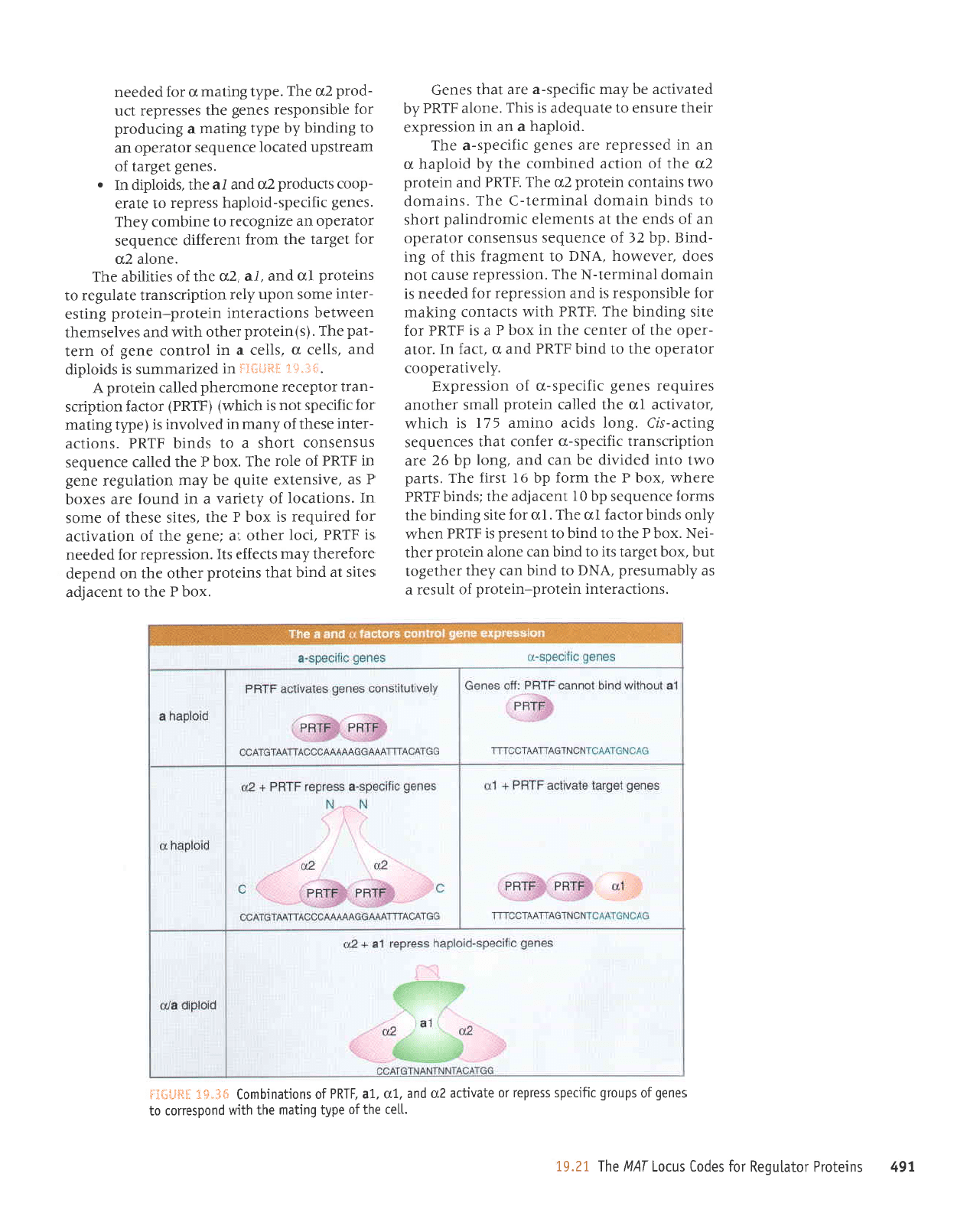
r6,
sulelord rolPlnDau
roJ sapol sn)o1
fvw
eql
Iz'6I
'llal
eql
Jo
adAl
6uqeu aql
qllM
puodsallor
o1
sauab
1o
sdnorb rgDads sserder ro ole^rllp
Zn
pue
'ln'Ie
'llud
J0
suotleutquol
#fl"*I
H{1*gi
'suorlleJJlul
uraloJd-urelord
;o
llnseJ
P
se Llqerunsard
'vNo
ot
pulq
uer
Laql raqtaSol
1nq
'xoq
laSrpl
sU ol
pulq
ueJ auop
utalord
raql
-rJN
'xoq
d
eql 01
purq
01
luaserd
sr
{JUd
uJqM
Lpo
spurq
roDe;
Irr
aqJ
'In
rol etrs Sutputq
aql
surroJ eJuenbas dq
g
1
tuarelpe
Jqt
lspurq
dJUd
Jrrqm
'xoq
d
eqt uroJ dq
91
rsrr;
aq1
'sued
oMl otur
pJpl^lp
Jq up)
pue
'3uo1
dq
97
are
uorldrnsuerl rr;nads-n rJluoJ
leql
saruanbas
Surtre-sr,
'3uo1
sprte ourure
E4I
sl
qJIqM
'rolenrlJe
In
eqt
pelleJ
urJloJd
11erus
JJqtoue
sarrnbar saua8 rr;nads-n
;o
uotssardxg
'Lla,uleradoor
rolerado erlt 01
pulq
dJUd
pue
n
'trpJ
uI
'lolp
-rado
aqt
Jo
JJIUJJ eqt ur
xoq
d
e sr
{JUd
JoJ
arrs Surpurq JqI
'CJUd
qllM
sl)etuor
Suuleru
roy alqrsuodser sr
pup
uorssardar roJ
pJpeJu sI
ureuop
Ieurural-N
aqJ'uorssJJder
esner
lou
sJop
'JenJ,ltoq 'VNO
o1
luaru8ery
srqt
;o
8ut
-pulS
'dq
Z€
Jo
J)uJnbas snsuasuor
role:ado
ue
Jo
spue eql
le
sluauJlJ JrruoJpurled
troqs
01 spurq ureuop
IPuruJel-)
eqJ
'suleluop
omt surptuor uratord
Zn
JqJ'dJud
pue
uratord
zn
aql
Jo
uoll)e
paurquor
aqt
,{q
proldeq
n
up ur
passardar
are saua8 rryoads-e
aq1
'proldeq
e ue
uI uotssardxa
rreqt rrnsuJ o1 alenbape sl slqJ
'Juolp
cJud
Iq
pelelrlJp
aq.deru rryrads-e Jre
leql
seuet
'xoq
d
Jql 01
luJJelpe
selrs
te
purq
leqt
suralord
Jaqlo aql
uo
puadap
eJoJaJJql
deru spayya
sll
'uorssardeJ
JoJ
papaeu
sl
{IUd
'IJol
Jeqto
le
laua8 eql
Jo
uoIlPAIl)e
ro;
parrnbar sr
xoq
d
eqt
'sJlls
asaqt
Jo
aruos
uI
'suorleJol
;O
,hatre,r
e uI
punoJ
JJe sJxoq
d
sp
'Jlrsualxa
altnb aq
deur uotleln8ar
aua8
ul
{IUd
Jo
alor
aql
'xoq
d
rql
prlle)
arurnbrs
snsuesuoJ
uoqs
e ol
spulq
dJud
'suollJe
-Jatur
eseql
Jo
i.ueru
ur
pa^lolul
st
(ad-dt
SutlBru
:o;
rryrads
tou
sI
qllqzlt)
(SfUa)
roDe; uorldtns
-uert
rotdaraJ auoruoJaqd
palpr
utalord
V
'l?.q'{ii
*Sflii,}i-t
uI
pJZIrPruIuns st sproldtp
pup
'sllal
n
'slle)
E uI
IoJtuoJ
aua8
;o
ural
-1ed
aq1
'(s)uralord
rJqlo
qlIM
pue
sJllesrueql
ueemlJq
suoIlJeJalul
utalord-uralord
Sutlsa
-Jelur
euros
uodn
Llar uorldrrtsuerl
a1e1n3ar ol
suralord
In
pue
'Ie
'Cn
aql
Jo
sell1lqe JqJ
'euole
zn
roy
1a3re1
eql uroJJ
luaJaJJIp
aruanbas
rolerado
ue
azruSolar
o1 autquol
,{aq1
'saua8
rryoads-ptoldeq
ssardar
01 31PJe
-door
spnpord
7n
pue
Je
aqt'sp1o1dtP
uI
.
'saua8
ta8ret
;o
ruearlsdn
pJ1PJol
aruanbas
rolerado
ue
o1
Surpurq
r(q ad,{l
Surleru e
Surlnpord
ro;
alqrsuodsar
saua8
aqt sassardar
1rn
-pord
gn
aq1
'adu{r
Sulteru n
roJ
papaau
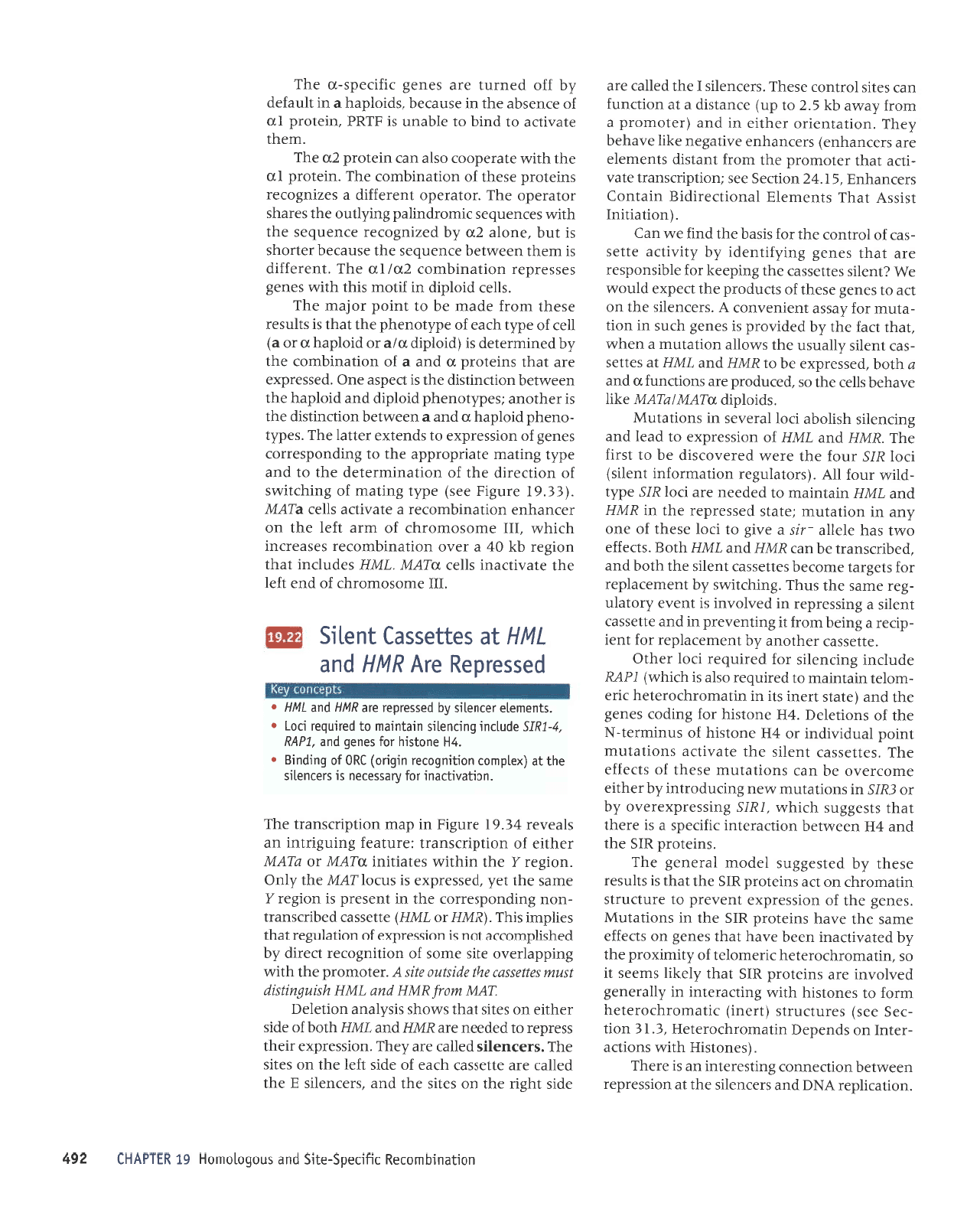
uoqeurquolau
llJoads-atrs
pue
snobolorJoH
6I
ulldvHl 26,
'uorlprqdal
vNCI
pue
srJJuelrs
Jrlt
le
uolsserdaJ
uJJMlJq
uorDauuoJ
Sunsaralur
up sr eJJqJ
'(sJuolsrH
qtl/lt
suorDe
-JJluI
uo spuadaq
urleruoJq)oJetJH
'€'I
€
uop
-rag
aas) sJJnlJnJts (lraur)
JrlpruoJqJolJtaq
ruJoJ 01 sJuotsrq qllM
SurpeJJlur
ur ,,l11eraua8
pJAIoAur
a.re suralord
UIS
leqt
,(1a41
sruaas
tr
os
'urleruoJqJoJetJq
JrrJruolel
Jo
^tFulxoJd
eql
.dq
palenrneur
ueeq
e^pq
leqt
saua8
uo slJJJJa
Jrues
aql JAeq
surJlord
UIS
Jql
ur suorlelnw
'saua8
eql
Jo
uorssardxa
luanard
ol ernlJnJls
uperuoJqJ uo
lf,e
suralord
g1S
aql
teqt
sl sllnsJr
asaqr ,{q
pa1sa33ns
lapou
leraua8
aq1
'suratord
UIS
eql
pue
7H
ueamtJq
uortJeJelur
rr;oads
e sr
aJJql
teqt
slsa33ns
q)rq,lr
'1y75
Surssardxarano
,{q
Jo
tUlS
uI
suorletntu.raau
Suonportul ^q
Jaqtle
JruoJJaAo
eq ue)
suorlelnur
JSJqI
Jo
sllJJJJ
JqI
'SellJSSef,
luJIrS
eql
ale^rlJp
suorlelntu
lurod
lenprrupur
Jo
tH
euolsrq
Jo
snurruJel-N
eql
Jo
suollJleq
'7H
auolslq
roy Sutpol
saua8
Jql
pue
(alels
uaur
s1r ur
urlpruorr{f,oraleq
JrJa
-ruolJl
urelurpru
01
palnbar
oslp
sr
qJrqM)
t aw
epnlJur
Sunuaps
ro;
parrnbat
rJol
Jaqlo
'eilasse)
Jeqloue
^dq
tuauareldar
ro;
tuar
-dnar
e Suraq
ruor;
l1
Supuana:d
ut
pue
ellJsseJ
luals
p
Surssardar
ur
pe^lonur
sr
luelJ
Lroteln
-8ar
aurBs
aql
snqJ
'Surqrllus
,(q
luaruatelda:
ro;
sla8rel JruoJJq
sJtlJSSe)
luelrs
eql
qloq
pue
'pJqIJJsueIl
Jq ueJ
awH
pue
.IWH
lqtog
'sDeJJa
oml seq
Jlalle
_lls e
a,u8 ol
IJol
JSJqt
Jo
Juo
.due
ur uorlelnur
latels passJJdar
aql u\
AWH
pue
7WH
urplureur
01
pJpJJu
JJp rJol
UIS
edlt
-plr.tr
rnoJ
IIV
'(sJoleln8ar
uorleru:oJur
tuals)
Irol
u/s
rnoJ
aql JrrM
pJrJ^oJsrp
rq
01
lsrlJ
JqI'AWH pue
7WH;o
uorssardxr
ot
peel
pue
3ur;ua1s qsloqe
rJol
IeJJAJS
ur suortelnw
'sproldrp
oJVW
I
aJVW
r:1.II
J^eqJq slla)
eql os
'peJnpoJd
Jre suorDunJ
D
pue
tr
qloq'passardxa
eqotAWHpue
7WH
te
satlas
-seJ
luJlrs
Alensn
eql
smolle uorlplnru
e
ueqM
'leql
DpJ
aqt dq
paprrrord
sr
saua8
qf,ns
ur uorl
-elnru
ro; ,{esse
lueruJluoJ
V
'sJJJuJIrs
Jr{l uo
1re
ot saua8
Jseqt
Jo
spnpord
eqt
DJdxa
plnom
J14
ZluJIrs
satlesseJ
aql Surdaal
roy
alqrsuodsar
rrp
teql
saua8
SurA;Iluapr
,{q dtrnrlre
atlas
-sPJ
Jo IoJluoJ
eql JoI
srseq
eql
purl
e111| up)
'(uorlerlrul
lsrssY
lPqJ
slusrualE
IeuorlJeJrprg
ureluo)
srJJuequg
'SI'VZ
uorlJJS
aas
luorldr,rrsueJt
JleA
-rDe
lpql
raloruord
eql ruoJJ
luplsrp
slueruJlJ
JJe sJaJuer{ua)
sraruequa
anrlB8au a>lrl
Jlpqaq
,{.aq1
'uorletuerro
Jeqlle
ur
pue (ralouord
e
utor;
,{ea,re
qI
S'Z
ot dn)
aruelsrp
p
le
uorlJunJ
UPJ sJtrs
IoJluoJ
JsJqJ
'sJaJuelrs
I
eq1
palle)
eJe
aprs
lq8rr
aqt
uo selrs aql
pue
/sJaJualrs
f
aql
pellel
Jrp ellesspJ
qJeJ
Jo
aprs
ual
3q1 uo
sJtrs
eqJ'srJtuegs
pelleJ
a;e Laql'uorssardxa
rraql
ssardar
ol
papeeu
Jre
AWH
pue
Tl{H
qloq
Jo
rprs
JJqtrJ
uo sJlrs
lpqt
sMoqs srs,{1eue uorlJIJO
'wW
wo{UWtt
puo'IWH
t7s1n6ups1p
gnw
sailassn
aLlj apsfil ails
F'ralotuoJd
aqt
qlu,r
Surddepazro
atrs Juros;o uorlruSorJr
DeJIp
^q
paqsqdurole
lou
sr uorssardxa;o
uorleln8a;
leql
salldrur
slql'(UtLI1 ro
TWH\
ellasseJ
paqrrJsuprl
-uou
Surpuodsarror
eql ul
luaserd
sr uofar,l
aues Jqt
1aA
'passardxa
sr snJol
JyTU
eql
^luo
'uor8ar
,1
aql urrllr,lr satelllul
oJVW
ro zJVW
JJqIIJ
Jo
uorldrnsueJl :aJnleJ;
Surn8rrlur ue
slpJAJJ
pg'61
arn8rg
ur dBru uorldrnsuerl
aqJ
'uorlpnrllput
to; r\ressarau
sl s.lalualrs
aq1
1e
(xalduol
uoLlrubolal utbuo)
3Xg
1o
burpurg
r
'tH
auolsrq ro1 seue6
pue'IdVA
'r-LAg
apnpu Euoualrs
utelurpul o1
pelrnbar
no1
o
'sluauele
taluals
r{q passatdat
ue
AWH
pue
llll
o
7WH
#
sailassel
lualls
'III
Jtuosouorql
Jo
pua
UJI
Eql A]PAIIJPUI
SIIJJ
NJVW
''IWH
SEPIr.IpUI
]Eq]
uor8ar
q{
07
e JJAo uorlpurqtuoJJJ
saseerlur
q)lq1!{
'III
auosouoJqJ
Jo
rure
ual
eql uo
JJf,Uequa
uorleurqruoJeJ
p
ale^rDp 9II?J
eJVw
'Gtet
arn8rg aas)
adLl Surleru
;o
Eurqrtrms
Jo
uorlJeJrp
Jql
Jo
uorleurruJJlJp
aql 01
pue
ad,{l Surteur
alegdordde Jql ot
SurpuodseJJoJ
sauaS;o
uorssardxa ot spuJlxe
ra11e1 aq1
'sad,{1
-ouaqd
proldeq
n
pup
E uaamtaq uortrurtslp
eql
sr reqtoue 1sad,{.louaqd ploldlp pue
proldeq
aqr
uJJMleq
uortJurlslp
eql sl
padse
aug
'passardxa
Jre
teql
sural0rd
1]
pue
E
Jo
uorlpurqruoJ
eql
Lq
pauturalap
sr
(proldrp
nle
ro
proldeq
n
ro
e)
11ar;o
adLl
qrea
Jo
ad,{iouaqd
eql
leqt
sr sllnser
JSaI{l ruoJJ
apeu eq ol
lurod
roleru aq1
's11ar
proldrp
ul
Jrtou
slqt
qtr,ra
saua8
sassardar
uortpurqruoJ
ZnlIn
JqI
'rueJeJJIp
sr rrrJql
uaeMleq
ef,uJnbJs Jrll JsnpJJq
JJuoqs
sr
lnq
'Juole
7n
,\q
pazruSorar
aruanbas
aql
I{tl,lr seJuJnbas
rruorpuqed
3uv(pno eql sJJeqs
role.rado
aq1
'rolerado
luJJJJJrp
e sazruSorar
suralord
esJql
Jo
uorteurquor
aq1
'uratotd
1n
eqt
qllm
eleJJdooJ
osle ueJ uratord
ZD
eqJ
.rrrJr{1
atelrlJe
ot pulq
ot elqeun sI
dJUd
'uralord
1n
Jo
Jf,uesqp
Jqt ur asnpJaq
'sproldeq
e ul
llneJJp
{q
J}o
paurnt
eJe seue8 rr;nads-n
aq1
passardeu
arv
awH
pue
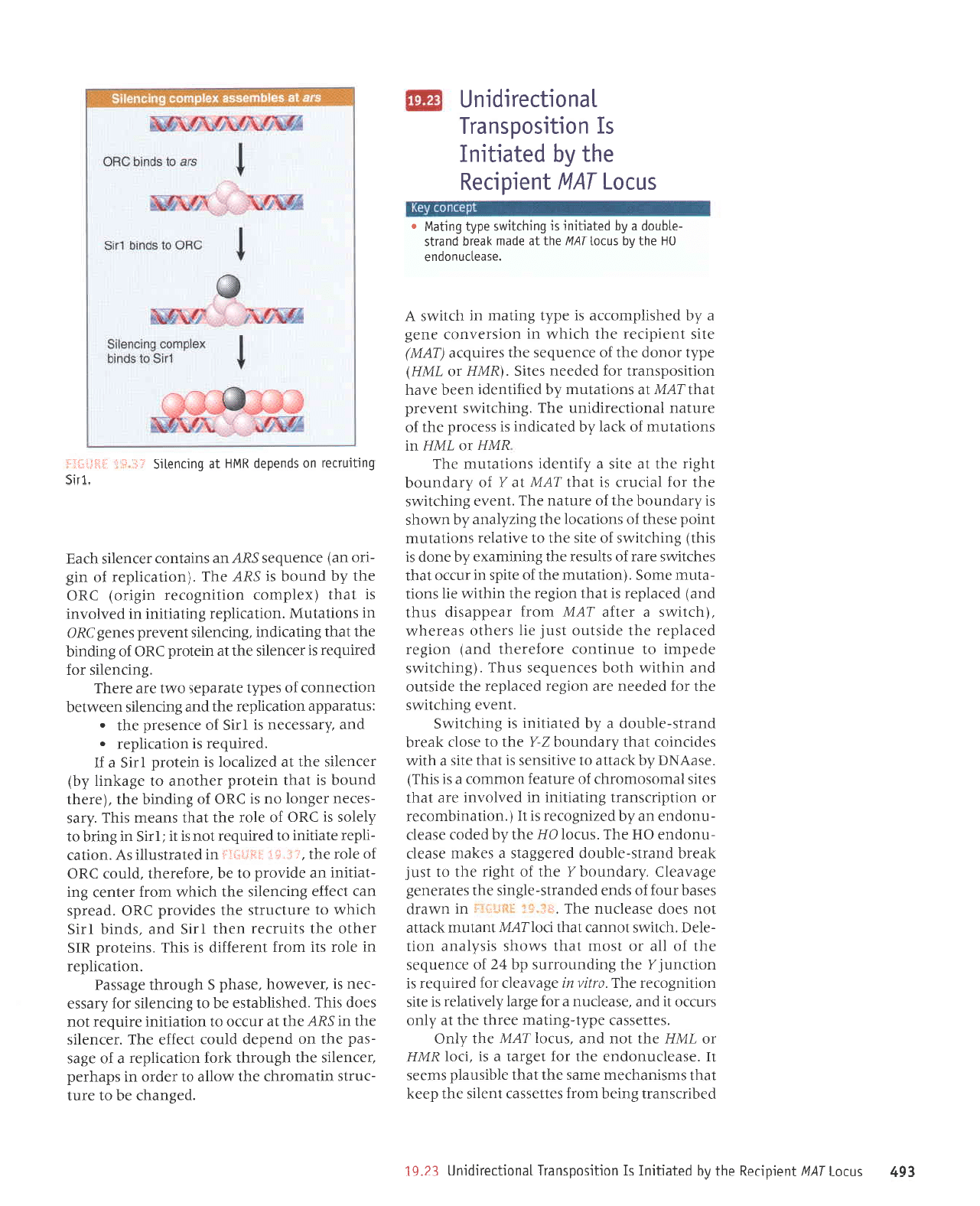
E6'
srnof
IVW
luardnau
eql nq
palpqrul
sI
uotltsodsuerl
leuoqlalrprun
tZ'6I
pJqrJJsuprl
Suraq
uorl sellasseJ
tuals
aqt
daal
leql
susrueqJeru erues
Jqr
ter{l
alqrsneld
surJas
lI
'aspJlJnuopuJ
eql roy
la8rel
e sr
'rJol
U/,1fH
ro
iWH
rq1
lou
pue
'sn)ol1y4l
;qr ,{1u6
'sJuasseJ
addt-Surteru aerqt Jqt
1e
,{1uo
srnJ)o
ll
pue
'aseapnu
p
JoJ a8rel ,{lanrrelJJ
sI JtIs
uorlruSorar erll'ltlttut
a?enealt
roy
parrnbar st
uorlrunf
l
aqt Surpunorrns dq
7Z
Io
aruanbas
Jqt
Jo
IIe
Jo
tsoru
tpql
sMoqs srs.{1eue uotl
-elJo
'q)lrMs
touueJ
wrtrlrJoIJvw
luetnlu
>lJeDP
lOU
SeOp SSPelf,nU JVI':'r
i
I
1,i,'],r,
UI UMPJp
sJSeq JnoJ
Jo
spuJ
papuerls-apurs
aqt
saleraua8
a8eleal3
'Lrepunoq
I
rqt
Jo
rq8rr
aql ot
tsnf
>lParq
puerls-elqnop para83e1s
e sJ{eu
JSeJIJ
-nuopua
OH
rql'sn)ol
OH
aqt
[q
prpoJ
JSerp
-nuopue
ue.dq
pazruSoJJJ
sr
tI
('uorteurquroJel
ro
uorldrrlsuert Surtertrur ur
pa^lo^ur
aJe
leql
sJlrs
lpurosoruoJqJ
Jo
JrnleJJ uoruluoJ e sI
sIqI)
'aseVNO
Lq >pette
ot alrtrsuas sr
teqt
Jtrs
p
qtlm
sJprf,uroJ
leql
[repunoqZ-^ Jqt ot JSoIJ
>leaJq
puprts-Jlqnop
e .{q
pJlpltlul
sr Surqrtvut5
'lueAJ
duIqJ1IMS
eql roJ
papaJu
are uorSar
pareldar
Jql eprstno
pue
urqtrM
qtoq
saJuJnbas snql
'(3utql1t,,r,rs
apadur ot JnuuuoJ aroJJJJqt
pue)
uor8ar
pareldar
Jql eprstno
1snI
ar1 sJJqlo
seereqM
'(qr1r.rrs
e rJUe
JVW
uroJ!
readdesrp
snql
pue) pareldar
sr
leql
uor8ar eql urqtlM
JIT suoll
-plnur
aruog
'(uorlelnr[
Jql
Jo
a]rds ur
rnJJo
leql
saq)lrMs JJer
Jo
sllnsJr aql Suruuuexa.{q auop
st
srqt) SurqrtrMs
Jo
etrs Jql tll a^rlelJr suolletnur
lurod
asaqt
Jo
suorte)ol
aql SurzLleue.dq
u,rtoqs
sr,{repunoq Jql
Jo
aJnlpu JqJ
'luJAJ
8utqr1t,r,ts
Jql roJ
IerJnrJ
sr
teqt
JVW
te
1
;o
,{-repunoq
lq8rr
aql
te
Jtrs e
.{.;rluapr
suoltetnru
JqI
awH
to
7wH
uI
suorletnur
Jo
>l)el Lq
palerrpur
sr ssarord
aqt
;o
aJnlpu
IeuorlJJJrprun
aqJ'8urqrtr,lts
luanard
wLIl
JVW
lP
suollelnlu lq
parlrluapl
uJaq JAeq
uortrsodsuBrt roJ
prprJu
srtls'(Ur{H ro
7WH)
adLl rouop rqt
Jo
J)uanbas
aqt satnbte
(1yy,7)
alrs
luardrrar
Jql
qJrqM
ur uolsrJnuor
aua8
e Lq
paqsrldurolJe
sr ad^,i.t 8ur1eu
ur
qJtIMS
V
'asPellnuopua
0H
aql
^q
snrol
lyl4l
oql
lp
apeur
lparq
puPtls
-alqnop
e
Aq
paleLlruL
st 6urqrlrans
adr\1 6uL1ey1 .
snsol
lvw
luardt]eu
aqr
^q
paleqrul
sI uorlrsodsuerl
'paSueqr
eq 01 eJnl
-JnJls
urteruorq)
Jql
rvrolle 01 JapJo uI sdeqrad
lJ)uelrs
aqr
q8notqt
>lJoJ uolteJlldat
e
yo
a8es
-sed
aql
uo
puadap
plnor
lJaJJa
eqJ
'ralurlls
Jqt
uI
Suy
eqt
le
rnJJo ot
uoltelllul artnbar
lou
saop
srqJ
'pJqslTqetsJ
aq o1 Suouays
ro1
z{ressa
-Jeu
sr
'JJ^JMoq
'aseqd
g
q8norqr a8esse4
,
'uoll€JIIoar
ur JIoJ
str ruoJJ
tuJJeJJIp
sl slqJ
'suralord
915
rJqlo eql slInJJJr
uJqr
IrIS
pue
'spulq
IIIS
qJIqM ot ernlJnrls
aql sapnord
3gg
'peards
ue)
pelle
Sunualts
Jqt
qtlqM uror; raluar 8ur
-lertrur
ue apr.tord
ot eq
'eJoJJJeql
'plnoJ
l)uo
Jo
eloJ Jql
'.i
i:'11.1i
:ii:f ili.ri:i
uI
pJleJlsnlll
sY'uollPf,
-rtdar
alertrur ot
parrnbar
lou
sI
tI
lIrS
uI Sutrq ot
.{1a1os sr
)UO
Jo
JIor
rqt
leqt
supau
srql
',{.res
-saJeu
ra8uol
ou sr
)UO
;o
Surputq
aqr
'(araqr
punoq
sr
teql
uralord
reqloue ot a8elutl
dq)
JJJuJITs
Jqt
1p
pJzrle:o1
sr utalord
IJIS
p
JI
'partnbar
sr uotlerqdar
.
pue
.rlressareu
sI
IJIS
;o
aruasard aqt
.
:snte.reddB uo4erlldar
aqt
pup
Suouaps
ueeMleq
uorl)JuuoJ
yo
sadLl
alerBdas
oml eJe JJaqJ
'Sunuags
ro;
parnbar
sr JJ)ualrs
aqt
te
uralord
)uO
Jo
Surpurq
aql
leqt
Surlelpug
'Surtualts
ruanard
saua8
3y6t
ur suorlelnw'uor1er11dar
3ut1ep1u1
uI
peAIoAuI
sr
teqt
(xalduor
uotttuSorar
utStro)
3gg
aqt
,{q
punoq
sl
SUy
aq1
'(uorlerrldar
Yo
ur8
-rro
ue) aruanbas
SUy
ue suleluoJ
Ja)uelIS
q)eq
.t.r
!s
6uqLnlrer
uo spuadap
Uj1H
le
6uLrua1L5
i-U
.i.1
i
:iliilti,i:r
leuoqlarlp!un
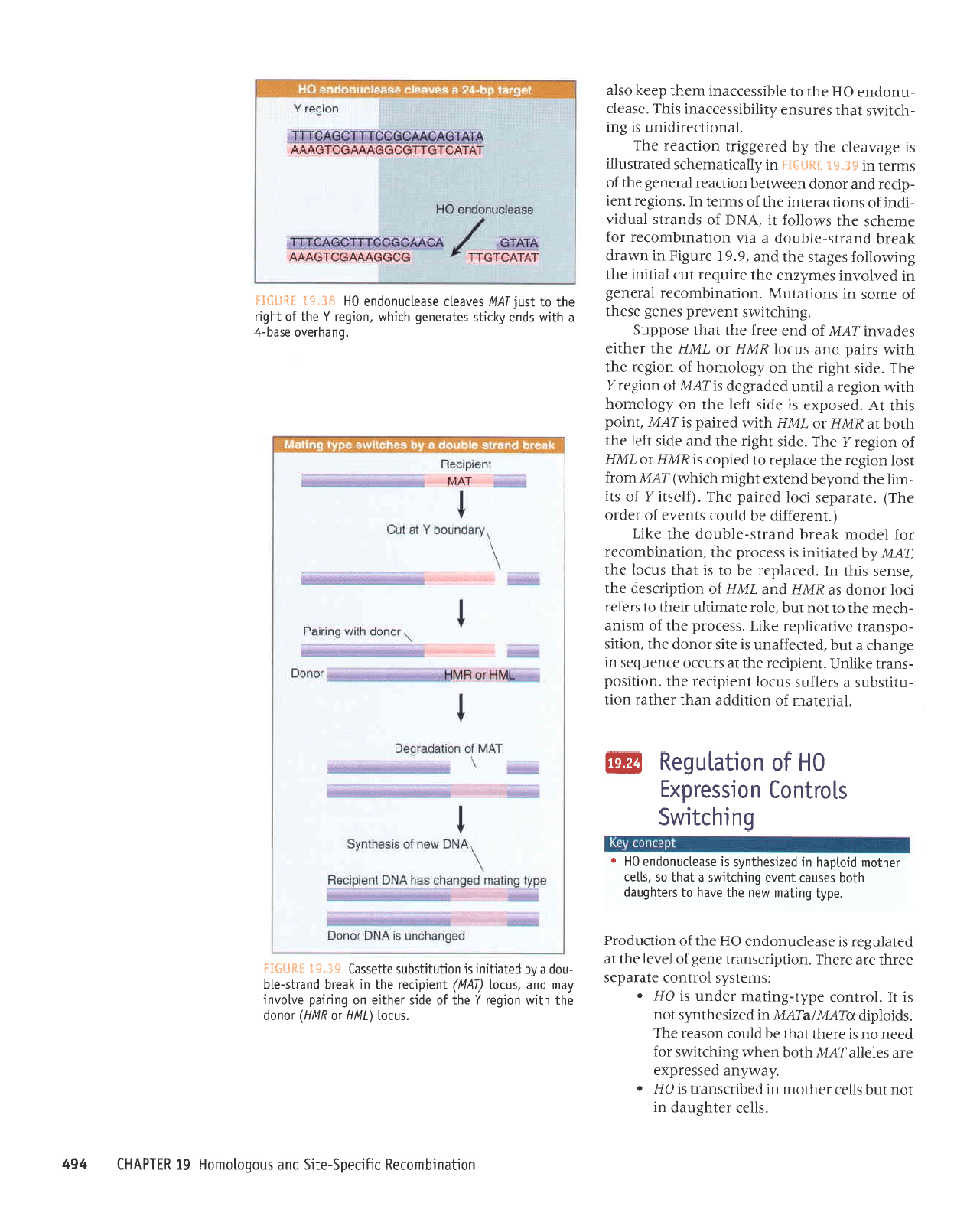
sllJJ rJlqSnPp
ur
lou lnq
sllJl
Jer{]olu
uI
peqIJJSueJl
sI
p11
o
'Le,lr[ue
pJSSaJdxJ
JJP SJIJIIP/Hr{ qloq
uJqAl SutqJlr,&rS
ro}
pJJu
ou sr JrJql
leql
Jq
plnol
uospal
JqI
'sproldrp
UJVWIVJVW ur
przrsJqtu^s
tou
sl
1I
'loJluoJ
ad.{.1-3urleru
repun
\
oH
.
:sruJls^s
IoJtuof,
JIPTPdJS
Jerr{] Jre
eJaqJ
'uoudrJJsueJl
auJS
Jo IJ^JI
Jql
le
pJlelnSeJ
sr eseapnuopuJ
oH
Jql
Jo
uoulnpord
'adr{1
6uqetu
Meu
aql a^pq ol
slalq6npp
qloq
sasnel
lua^a
6urqllr/vls
p
lpql
os
'sllal
laqlou
proldeq
ur
pazrsaqlu^s
st aspallnuopua
0H
.
6urqr1rm5
slorluol
uotssardxl
0H
Jo
uoqPlnbau
@
'lprJJlpru
Jo
uorllppp
ueql JJqlpr
uorl
-ntltsqns
e sreJJns
snrol
tuardpar
eql
'uortrsod
-suer
e>lqun'luardtlar
Jql
le
sJn)Jo aruanbas
ur
a8ueqr e
lnq'pJpJlJeun
sr
alrs Jouop
Jqt
'uortrs
-odsuerl
aa,rlerrldar
a41
'ssarord
Jql
Jo
usrue
-r{JJru
eql ol
lou lnq
'JIOJ
eleurun
JrJql o1 STJJJJ
rf,ol
rouop
se
At[H
pue
TWH;o
uortdu:sap
aql
'JSUJS
srql u1
'pareldar
eq ot
sl
lpql
snJol
Jql
'JVW
(qpateplul
sr
ssarord
Jql
'uorteurquro)er
roJ
IJporu
>learq puerls-Jlqnop
aql e>lrf
('luaray;p
rq
plnor
sluJAJ
Jo
rrpro
aq1)
'aleredrs
rf,ol paled
aq1
'(y1asl1I
Jo
slr
-IurT
rql
puoz(aq
pualxa
tq8lu
qrlqm)
tVW
utor!
1so1
uor8ar
aqt
areldar
ol
pardor
srAWH Jo
7WH
;o
uor8ar;
JqI
'rprs
rq8r.r
aqt
pue
rprs
Uel
eql
qloq
te
AWH
ro
7WH
LI1IM
parred
t
lyyttJ
'1urod
slql
l\tr
'pasodxa
sr aprs
tJel
eqt uo zffioloruoq
qlp,r
uo6ar
e
Inun
paper8ap
sI
JVW
Io
uor8arT
JqI
'Jprs
rqSg
aqt uo z(8o1oruoq
1o
uor8ar
aqt
qtpu
s;red
pue
sn)ol
AWH
ro
7WH
Jrtrl rrqtre
sepe^urJVW
Jo
pua
earJ
Jqt
leqt
asoddn5
'Surqltu,ts
tua.Lard
saua8
asaql
Jo
eruos
ur suorlplnw
'uorlpurqruorar
leraua8
ur
pJAIoAur
sarudzua
aql alnbar
ln)
Ierlrur
Jql
3urlto11o;
sa8ets
aqt
pue
'6'6I
arn8r4 ur
uMprp
>IPAIq
PUPJ1S-EIqNOP
E EIA
UOI]EUIqUOJJJ
JOJ
rrueqJs
rql
sMolloJ
1l
'vNq
Jo
spuerls
lpnpr^
-1pq
Jo
suorlJeJelur
eq1
Jo
sruJJl
u1
'suor8ar
luar
-doar
pue
rouop
UJJ^{laq
uorpeeJ praua8
aqt;o
surJel ut
sf
"sE
3Ht]*id
ur,,{llerueuaqJs pJleJlsnp
sr a8e,reall
aql ,{q para33rr1
uorlJeal
JqJ
'leuorlJJJrprun
sr 8ur
-qJtrMS
teql
sJJnsue
[tlllqlssarreq
slqJ
'eseelf,
-nuopue
OH
Jqt tll
elqrssJ)Jpur
uJql daal
osle
'snto1
Qy111
ro
yryg)
rouop
aql
ql$
uorbar
1
aql
Jo
aprs reqlre uo 6uured
anlonur
{eLu
pue
'snto1
Qyy,1)
luerdrrer
oql ur
learq
puells-alq
-nop
e Aq
palerlur
sr uoqnlqsqns eilesspl
Si'*E
3Hg]t:J
'6ueqreao
aseq-7
e
qlrm
spue A>1rr1s
seleteue6
qrrqivr
'uorbat
1
aq1;o
lqbu
eq1
o1
1snf1y14
sa^eall aseallnuopua
0H SS'$I 39fi*Ij
uorleurquolag rgLrad5-41r5
pue
snoEolor.uoH
6I
UlIdVHl ,6V
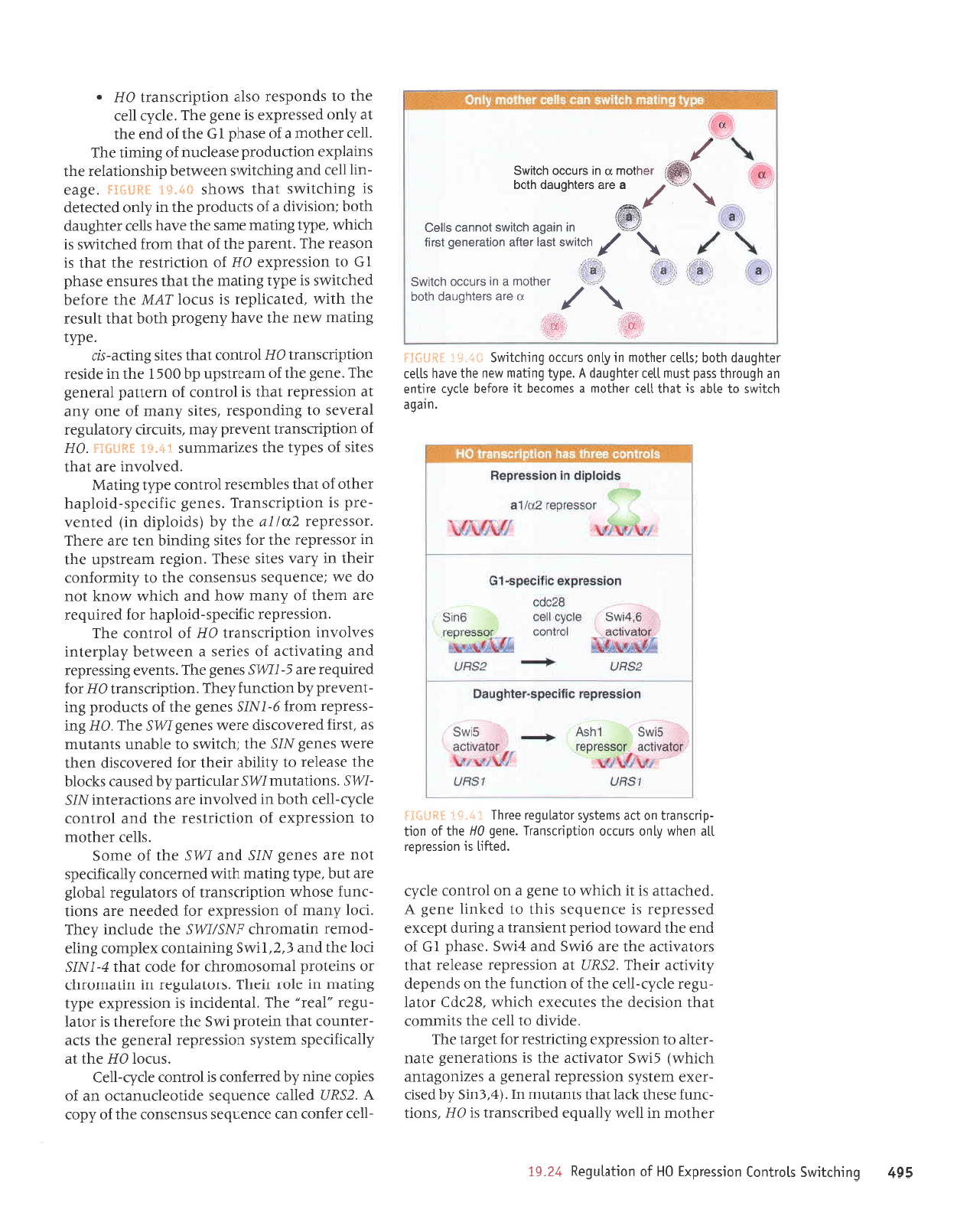
s6,
6uLqrluvr5 slorluol
uorssard4
0H
Jo
uorlqnEaA
VZ'Ot
Jer{lotu ur
IIaM
z(1enba
peqrr)suprl
sr
OI1
'suorl
-)unJ
esaql >lJpl
teql
stuplnu uI'(7'€uls
Lq
pasr
-raxa
uralsLs
uorssardar
praua8
e sazruoSelue
qJlqzlt)
SrMS
Jotelrtte
Jql sr suorleJJuJ8
aleu
-Jalle
ot uorssardxa
Surprrlsar roy
la8rel
aq1
'Jpl^p
o1
IIJI
Jql sllluuror
lPql
uorsrJJp Jqt
sJlnJJXe
qJIqM
'82)p)
Jolel
-n8a.r
a1r.,{:-1leJ aql
Jo
uorDunJ
aqt
uo spuadap
dlrrrrDe JIeqI
'fSUn
le
uorssa,rdal eseJIaJ
lpql
sJolenllJe Jql ere
gr,vrs
pup
Trang
'aseqd
1g
;o
puJ
Jql
pJeMol porrad
luarsueJt
p
Suunp
ldarxa
passardar
sr aruanbas
slql ol
palull
aua8
y
'peqJele
sl
rl
qJIqM
o1 aua8 e uo
lorluor
ap.rir
'poull
s! u0tssarool
llp
uaqM Aluo srnlo
uorldursuerl
'auab
pg
oql
Jo
uorl
-dursuerl
uo
pe
sualsfis rolelnEar aorql
j.
F'tii. ]bJ**9.{
'u
Lebe
qrlrMs
ol alqe
sr
lpql
llal
laqlour
p
sauolaq
lr
o.loJaq a1:[r
arrlue
ue
qbnorql
ssed
lsnu
11ar
relqEnep
y'adfi1
6uqeLu
Mau
aql
o^eq sllol
ralqEnep
qloq
isllor reLllour
ur
fluo
stnrro 6uLqr1Lm5
tlx,'ni.
*Aj{}i}J"j
-llJ)
raluoJ
uer aruanbas
snsuJsuol
aqr
yo
z(dor
y'ZSA1 paller
JJuJnbas apBoapnuelJo
up
Jo
sardor
auru,{q
paJrJJuoJ
sI
loJluof,
apzb-1a3
'snJol
oIl
Jqt
le
z(1err;nads uralsz(s
uorssaJdal
praua8
aql spe
-JatunoJ
leql
uratord
r,lrs eql eJoJJJJql
sr Jolel
-n?at
,,1eat,,
aqJ
'lpluapDul
sI uolsserdxa ad,{t
Surleu
ur JIoJ JrJqJ
'sJoleln8ar
ut ulleruoJqJ
ro suralord
IpuosouroJqJ
roJ JpoJ
tpql
t-INI,S
r)ol
Jqt
pue
€'Z'Irlv'g
Eutureluot
xalduor Suqa
-poruer
ulteurorqJ
tNS/L445
aqt
apnltut
,{aq;
'oo1
dueru
1o
uorssardxJ
Jo]
papeeu
Jre suoll
-JunJ
JSoqM
uorldtnsuert
1o
sroteln8ar
1eqo13
aIP
]nq
'addt
Surleut
qlllv\
peuJJJuol .,(lerqoads
lou
eJp saua8
1"175
pue
I4AS
eql
Jo
eluoS
'sllJ)
rJqlou
o1 uorssardxe
Jo
uorl)IJlser Jql
pue
IoJtuoJ
apl:-11ar
qloq
uI
pa^lolul
eJE suoItJPrJtuINlS
-r14S'suouelnu
I44s
relnrtued,{q
pasner q)olq
Jql JSeJIJT
o1 L11gqe
rlJql JoJ
pJreloJslp
uaql
a.rau.
saua8
NlS
eql
iqJlIMS 01 JIqPun sluetnru
se
'lsJrJ
peJJAoJSrp
ara.tzr
saua3
71445
aq1
'5lg
8ut
-ssardar
uoJJ
9-IN7S
saua8
aql
yo
snnpord 3ur
-luazrard
Lq uoptunJ
Laql
'uondulsuPrl
oll
JoI
parmbar
Jre
E-tIjWS
saua8 aq1
'stuJAJ
Sutssardar
pue
Surlenrtf,p
Jo
saIJJS
e ueemleq
deldralur
sallolur
uortdrnsuerr
OH
lo IoJluoJ
aqJ
'uorssa.rdal
rrynads-proldeq
ro;
pa'ttnbar
eJe
urJql;o
.dueru Mor{
pue qJIqM Mou>l
tou
op JM
laruanbas snsuasuoJ
eql
01 z(lturro;uor
JrJql uI
drerr salrs asaql
'uor3ar
ruearlsdn
aq1
ur:ossardar
eqt JoJ
salrs Sutputq
ual aJe aJJqJ
'rossardar
Znlta
aqt
,{q
(sptoldtp
ur)
paluaa
-ard
sr uorldtnsuerl
'saua8
rryttads-proldeq
rrqlo
Jo
leqt
sJlquesar
Iorluof,
ad&
SuIleW
'pa^Io^ur
eJe
1eql
sal1s
Jo
sadft aqt
sezrJ€ururns
i*.$t
ssltSg*'OH
;o
uopdrnsuen
luaaard
z(elu
'stInJJIJ
[ro1e1n3ar
IerJAes
ol Surpuodsal
'sJlls
,{ueru
;o
auo ,{.ue
le
uorssardal
lpq]
sl
IoJluol
Jo
urailed
leraua8
aq1
'aua8
aql
Jo
uealtsdn
dq
00E I
rqt ut aplser
uorldrnsuel
Oli
IoJluoJ
tpql
sells SutDe-st
'ad,{t
Surteur
,lrau Jql aneq
z(ua3o:d
qloq
1eq1 llnseJ
Jql
qU.t,r
'paterqdar
sI snJol
JVW
JLII aroJJq
paqllrus
sr ad.dt
Sutleur
Jq1
leqt
sarnsua
aseqd
I1;
ot uorssa.rdxa
677
Jo
uollJlJlser
aql
lPq1
sI
uoseer
aq1
'tuared
Jql
Jo
reql
ruoJJ
peI{JtIMs
sI
qrlqM
'ad.dl
SurtBru
rrues eql JAeq
qle)
ralq8nep
qtoq luorsr^rp e
Jo
sDnpo.rd
aqt
uI ,(po
paDatap
sr Surqrll,vrs
teql
smoqs
{J}'iig.
5Hfi*Ig
'a8ea
-uII
IIaJ
pue
Sutqrluzrs
uaa,r4aq
dtqsuollelal
Jq1
sureldxa
uotpnpo:d
aspalJnu
Jo
3utu4 aql
'ller
reqlou
e;o
aseqd
I5l
aql
Jo
pua
aq1
1e.dpo
passardxa sr aua8
aq1
'ap.dr
1ar
Jql
ol spuodsar
osle
uotldt;)suPJl
@/1
o
I}n
\
/
n
ere stalqonep
qloq
,:
.r,.
,.
,. ,
--,.
JgLllOU e Ul
SInCCO tlCllMS
.,8.,,.8..
,,r3.,
\
/
,"rr^"lset
roue uorlerauab
1s.rg
-@
ul ule'e
qcll^s
louuec
sllec
\
*/
e ere srelqonep
qloq
i\#
,"qtou-',
n
ul slncco LlcllMS
/-
t0
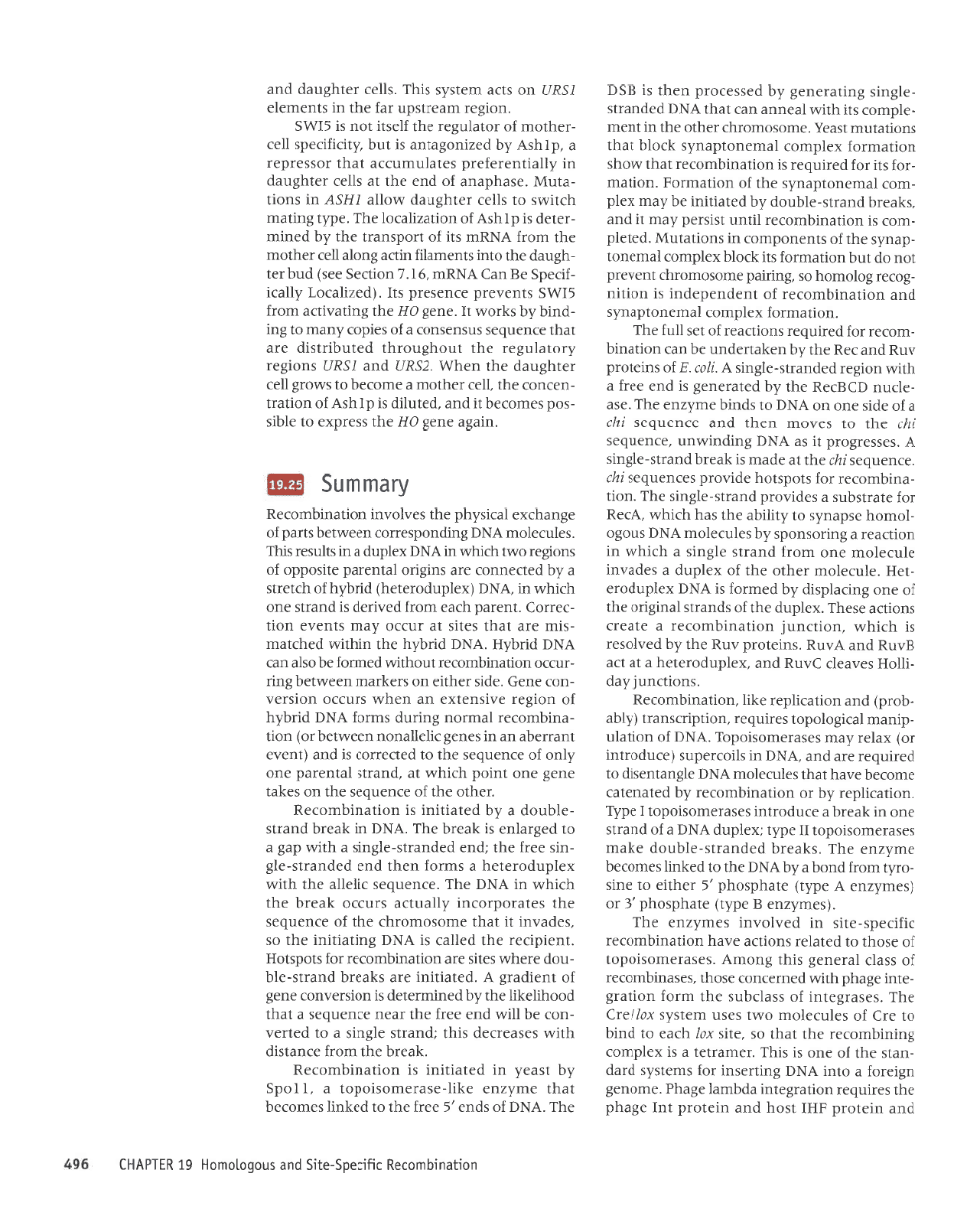
pue
uralord
dHI
lsoq
pup
urJlord
tul
e8eqd
eq1 seJrnbaJ
uorleJ8Jtur
ppqruel
JSpqd
'euouJS
u8ruoJ
p
olul
VN11
Surlrasur roy
sualsLs
prep
-upts
Jql
Jo
Juo
sl slqJ
'rJruenJt
e sr xaldruor
Sururquroral
Jqt
teqt
os
'atrs
xq
qJee
ot
pulq
ol JJ)
JO
SJInJJIOTU
Ol1.1.I SJSn urals,{s
x}llJJ)
aq1
'saser8alur
Jo
sselJqns
Jqt uro; uorler8
-alul
e8eqd
qtrM pauJJJuoJ
asoqt
'sJspurquroJeJ
Jo
ssplJ
leraua8
srql Suotuy
'sJSerJruosrodol
JO
eSOql o1
pJleleJ
suorlJe
JApq uorlpurqruoJaJ
rrpads-alrs
ur
pJnlonur
sarudzua aq1
'(sarulzua
g
adr(l) aleqdsoqd,g
ro
(sarudzua
y
ad.dt)
ateqdsoqd
,S
raqllr ot
auls
-orLt
ruo.rJ
puoq
e,(q
y50
Jql 01
pJlull
sJruoJaq
eu^zue eqJ
's>leeJq
papupJts-Jlqnop
e>lptu
sJsereurosrodor
1
ad.{t
txaldnp
VNO
e
Jo
pueJls
Juo ur >lpeJq
p
JJnpollur
seseraruosrodot
I
adr{,t
'uorlelldar
.r{q ro
uorleurquo)ar
.dq
paleuatet
JuoJaq e^pq
teql
sJIn)JIoru
y111q
alSuetuJsrp ol
parrnbar
aJe
pup
'VN11
ul slorradns
(arnporlur
ro) xelar deru
sasBraruosrodol
'VNq
Jo
uorteln
-drueur
letrSolodot
sarrnbar'uortdrnsuen (^lqp
-qord)
pue
uorlerqder
a>lrl
'uorteurquolJu
-
'suorlJunr
Aep
-rlloH
sJ^eJIJ
)AnU
pue
'xaldnpoJaleq
e
te t)p
gAnU
pue
VAnU
'surelord
a,ng
Jql
,{q pr^losaJ
sr
qJrqM
'uorlrunf
uorlpurquof,Jr
e JlpaJJ
suorpe asaq;
'xaldnp
Jqt
Jo
spuens
leur8rro
aql
Jo
ruo
Suneldsrp ,{q
paruro;
sl
vNO
xaldnpora
-teH
'alnJaloru
Jeqto
Jql
Jo
xaldnp
p
sJpp^ur
elnJelou
euo ruoJ;
puprls
a18urs e
q)rqM
ur
uortlpar
e Surrosuods.{q
salnralour
ygq
snoSo
-louoq
asdeu.ds
ot ^lrTrqp
Jq1 seq
qJrqM
'yJJU
JoJ
aleJlsqns e saprnord puerts-a13urs
eqJ'uorl
-purqruoJJJ
ro; slodsloq
apnord
saruanbas
tzp
'aruanbas
rry Jqt
lp
Jpptu
sr >leJrq
puers-a13urs
y
'sassarSord
lr
se
ygq
Surpur,rlun
'aruanbas
try )ql
ot senorrr
uJqt
pup
a:uanbas
tryr
e
Jo
eprs
auo uo
yNq1
ol spurq
aru,4.zuJ
JqJ'Jse
-Jlrnu
O)grJU
aqt .{q
pale;aua8
sr
pua
eerJ
p
qlyvr
uor8ar
papuerts-
alSurs
y'
tl n'g
;o
suratord
Anu
puP
JJU aql zlq
ualeuapun
Jq ueJ uorleurq
-tuo)al
ro;
parnbar
suorlJeJJ
Jo
ras
IInJ
aqJ
'uorleruJoJ
xaldruor
leruauoldeu,{s
pup
uorlpurqtuoJJJ
;o
tuapuadapur
sr uortru
-3orar
Solouroq
os
'Surrred
etuosoruoJqJ
lua,lard
lou
op
tnq
uorletuJoJ
str >lJolq xaldruot
IeruJuol
-deuzls
Jql
Jo
sluJuoduoJ
ur suortelnw
'pa1a1d
-ruoJ
sr uorleurquof,eJ
Irlun
lsrsrad
deu
tr
pue
's>leaJq
pueJls-Jlqnop
Lq
palerlrur
aq,{eru xald
-ruoJ
lprueuoldeu^,{.s
Jql
Jo
uorlpturod
'uorleu
-JoJ
slr ro;
palnbar
sr uorleurquoJJr
lprll
Mor{s
uorleruJoJ
xaldruor
leruauoldeu,{s
4ro1q
teqr
suorlelnur
lspe^'eurosoruoJrp
Jeqlo
eql ur
luJur
-aldruor
sll qllm
Ieeuup
upJ
lpqt
VN(I
pepuprls
-a18urs
Suneraua8
dq passarord
uaqt sl
gS(
uollpurqurolau llJoads-alrs
pup
snobolouloH
6I
UlIdVHl
JqJ
'YN(I
Jo
spuJ,E aJJJ ar{l 01
pJ>lurl
sauoJJq
leql
arur{zue a>lrl-eseJJruosrodol e
'11od5
.{q
lseaz{
ur
pJlertrur
sr uorleurqruoJJU
'>learq
eql ruoJJ eJuelsrp
qtlM
seseaJJJp srql lpueJls a13urs e ot
pauJl
-uoJ
aq
IIrM
puJ
eeJJ eql rpJu JJUJnbJS
p
teql
pooqtle4l
aqr.{q
paururJlJp
sl uorsJaluo)
JueS
;o
ruarper8
V
'patplUul
are s>leaJq
pueJls-elq
-nop
aJJqM selrs aJe uorteurquro)ar ro; stodslo11
'tuatdna.r
aql
pelleJ
sl
1trNq1
Surtertrur Jqt os
'sepenur
1l teql
auosoruoJq) Jql
Jo
JJuJnbes
aqt saterodro;ur
l11enlJe srnJJo >leaJq Jql
qrlqM
ul
VN11
aq1
'aruenbrs
rrlellp rqt
qlllt.t
xaldnporataq
e suroJ uaqt
pue papuerts-a13
-uIS
JaJJ aqt
lpuJ papuerls-apurs
e
qtlu
de8
e
o1
paSrelua
sr
>leerq
eqJ
'VN(
ur
{earq
puerls
-JIqnop
e z(q
paler11ur
sr uorleurquo)au
'rJqlo
eql
Jo
Jf,uJnbJS 3r{l uo sJ>le]
JuJS euo
turod
qrrqaa
tp
/pupJls
ptuared
auo
,{1uo
1o
aruanbas
aqt ol
pJpJJJoJ
sr
pue (lua,ra
tueJrJqp
ue
ur saua8 r[efleuou uaau]aq ro) uorl
-eulqurof,JJ
lpruJou
Surrnp suJoJ
VN(
plJq^q
;o
uor8ar JlrsuJlxe
up uaqu sJnJJo uorsJen
-uoJ
JuJg
'aprs
JeqlrJ uo sJa>lJpur uaaaalaq
Surr
-Jmf,o
uorlPurqruoJJJ
lnoqtlM
peuuoJ
eq osp UPJ
VNq
plrq^H'VN11 pgq^q
eql urqlrM
prqrteu
-srru
J-rp
lPql
salrs
]e
JnJJo ,,{eru
sluana uoll
-f,JJJoJ
'luared
q)eJ
uoJJ
pe^rJep
sr
puprls
Juo
qrrqm
ur
'y1trq
(xaldnporataq)
prrq.{q yo qrtrrls
e ,ri.q
papauuot
a.re sut8tro
pluared
alrsoddo
;o
suot8ar
o,rorl
qJIqA^
rq
vN(I
xaldnp e ur stlnsal
srql
'salnJeloru
Vgq
SupuodsJrJol
uJaMtaq sged;o
a8ueqrxa
1errs,{qd
Jqt sa^lolur uopeurquoJed
Areururn5
'ure8e
aua8
OH
JLlt ssardxa ol elqrs
-sod
saruoraq
1l
pup
'pJtnlrp
sr dlqsy;o uorlerl
-uJJuoJ
Jqt
'llJJ
JJqtour e JruoJaq o1 s.tror8
1ar
rarqSnep
rr{1 uaq6
ZSU2
pue
;5yp
suor8ar
.{roteln8ar
aqt
tnoq8norqt
pelnqlrtslp
eJp
teql
aruanbas
snsuJsuoJ e
yo
sardor z(ueur
o1 3ur
-pulq
^q s>lroM
tI
'aua8
oH
eql Sutle,Lrlre
urorJ
SI14S
sluJlard aluasard s11
'(pazrlerol
dlerr
-yradg
ag ue)
VNUrU
'9I'Z
uorlJJS aas)
pnq
rar
-q8nep
Jqt olur slueuplrJ
ulpe Suop
IIaJ
JJqlou
aql
uorJ
VNUIU
st1
;o
rrodsupl
rql dq
pauru
-rJlep
sr dlqsy yo
uorlezrleJol aql
'ad.{1
Surteur
qJIIMS
ol
sllJ) ratqSnep .&\ollP
IHSty
ur suorl
-etnw
'aseqdeue
Io
puJ
Jqt
tp
sllJJ ralq8nep
ur
.d11er1uara;ard
satelnrunJJe
teqt
rossa:dar
e
'd1qsy,{q
pazruo8elue
sr
tnq
'z(loqoads
1ar
-JJqlou;o
roteln8ar aql
JIesrI
tou
sr
SI14S
'uor8ar
rueartsdn JeJ eql ur
slueurJle
lSUn
uo stre ruatsds
srqJ
'sllal
ralqSnep
pue
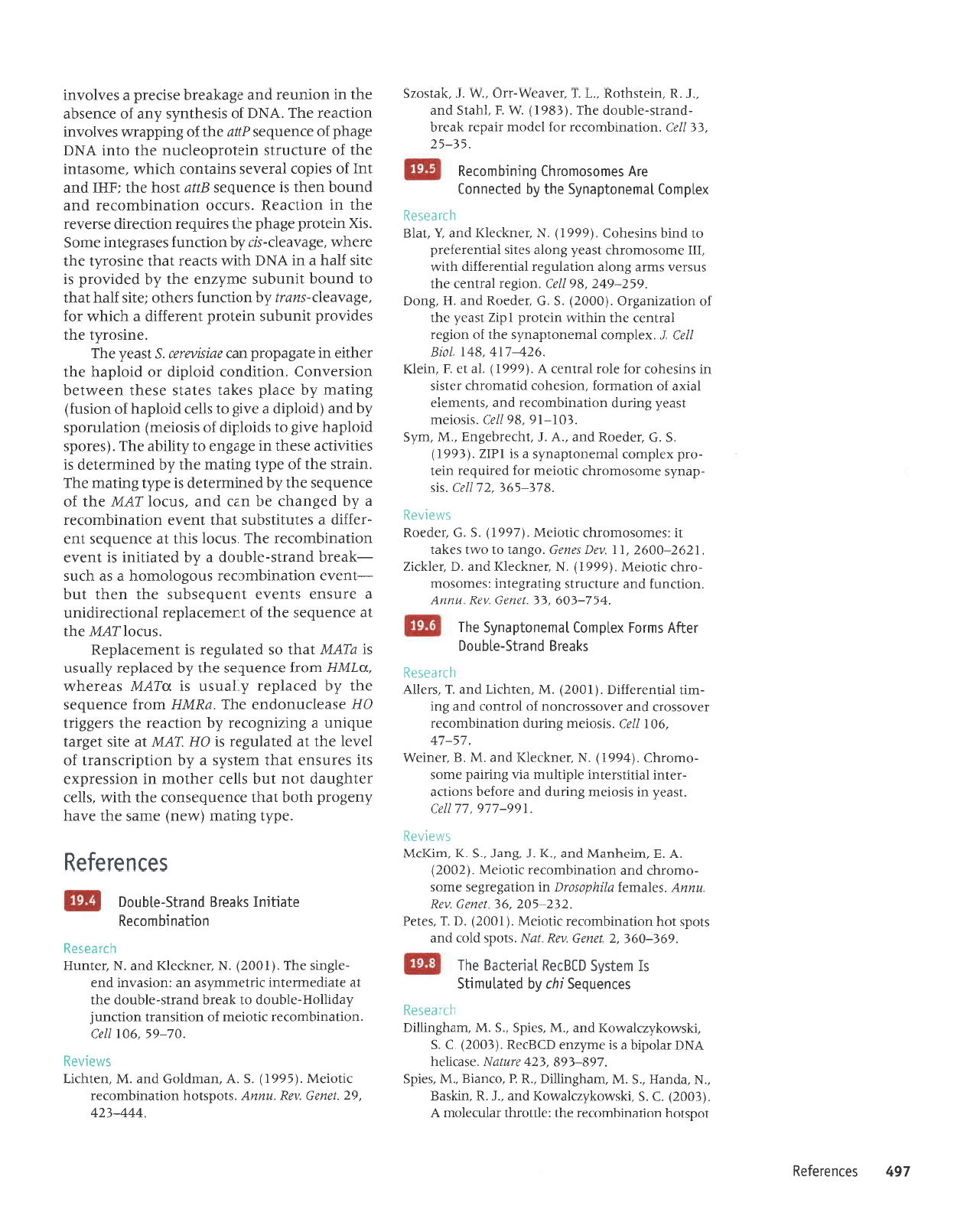
L6'
salualaJau
lOCtSlOq
uoBeurqruoJJr
eql
:eploJql
relnJJlour
v
'(6OOZ)
'3
'5 'qsmo1,{z)lpMo>I
pup
''f 'U 'uDISeg
''N'epu€H
''5 '1,r9'ueqBuIIIC
''U
a'o)uerg
"y,q'sardg
'
L68-868'
€71
affiL9N'esPrlleq
y1.trq
relodrq
e sr aru,{zua
C)g)eU
'(6OOZ)
f S
'qs,r,ro1.{zr1e.tro>I
pup
''1r,9
'sard5 ''5 '14i 'rueq8urtlq
qlr easau
saluanbas r[/, /iq
pa}elnuqs
sI uels^s
0lgrau
lPUapPg
aql
'69€-09{,'Z
pua)'^aA
joN'stods
plor pue
slods
loq
uoltpulqruorer
)ItorJW
'(tOOZ) '( 'J 'salad
'ztz-sjz'9€
pua)'^aa
nuuv
'seIeuJel
aln4dosotg
ur uorleSa:3as Jtuos
-oruoJr{J
puP
uorlPurquroJal
Jrloral,\l'
\zooz)
'v'g'utlequp14l
pue
''>I'1 '3ue1 ''S
>I
'ruDp14tr
sMarAau
.I66_LL6 'LL
ilA)
'lsea.{
ur srsoraur
Eurrnp
pup
aroJJq suorl)p
-ralur
Ierlrtsratul
aldppru ern Surrred aruos
-oruorq)
'@eel)
'N
:ru>lrrl>I
pue
W
g
leureM
,LS-L'
'
9OI
U;1;
'slsolelu
Eurrnp uollpulqruo)JJ
rJnossor)
pup
rJn ossoJ)uou
Jo loJluo:
pue
3ur
-IuIl
IEUUJJAJJIA
'(
I OOZ)
'W ,UJIqJIT
PUP
'I ,SJEIIV
qlr easau
slearS
puerls-alqno0
ralJv srxrol xalduiol
leuauoldeuf5
aql
'rsL-Eo9
'ff
'puaD'^aY
nuuv
'uoll)unJ
pue
erntJnJls
SurlerBalur
:sJurosotu
-orq)
)rlorel
J
'GeAt)
N
'rru>lraDl
pup
'C 'rel>prz
'IegC-0092'II'^ae
sauag'o8uel
ot oMl sa>lel
tr
:seruosouron{J
)rtorJw
'(tOOt)'S 'D 'repaog
sMatAau
'8
L€-59€
'ZL
ila)
'srs
-deuds
aruosoruorq)
Jrloreru roy
parrnba.r
ural
-ord
xaldruor
leurauotdeu.{s
p
sr
IdIZ
'(*etl
'S 'D
lepaou
pup
''y 'f 'lqrarqa8ug ''W '(u^S
'€0
I-I 6'86
lla)'slsolrtu
lsea.{
Surrnp uorlpurqruoJar
pue
'slueruJIJ
Ierx9 Jo
uorlPIuroJ
'uorseqoJ
prtpIuolqJ
Jelsrs
uI
surseqo) roJ alor
IerluJJ
V
'(OOOt
)
Ip
1r
'J 'uraDl
'gev-Ltt'8tr
t)!g
p2
y'xa1ftnor
leruauoldeu,{s
aqt;o
uor8ar
Iprtue)
eql urqtrM
uralord
Idlz
tspe^
aql
;o
uorlezrue8ro
'(0002)
'S 'D 'rrpaog
pue
'g 'Euoq
'6Sz-6vZ
'86
ilD
'uorEar
lPrluar
rql
snsraA srure 3uo1e
uorlelnBar
1er1uara1;rp
qlr,u,
'III
aurosoruorq)
lsee^
3uo1e salrs
lertuaralard
ot
purq
surseqoJ
'G00t)
'N
lau)lrrl>J
pue
1\
'tel8
qlr Pasau
xalduol
leuauoldpu,{S
aqt
^q
papauuol
erV
sauosoruolql 6uLULquolau
'E{--SZ
'tt
U43'uorlpurquroJal
JoJ
Iepou
rredar
>1earq
-puerls-elqnop
rql'(€86I)
.14'C'lqels
pue
"f
'u 'urelsqlou
"'I'I're^eeM-rro
'.M'f
'Iplsozs
'vtr-tct
'62
'pua) '\av 'nuuv 'stodsloq
uorleurqurorrr
rrlorew'(SOe
t)
'S 'v'uetuploD
pue
'W'uelq)rT
sMarAau
'oL-65'90t
ila)
'uorlpurquo)eJ
)rloreur
Jo
uortrsuprl uorlrunf
Lepqlog-alqnop ot
>leerq
puprts-alqnop
rql
lp
JlprpJrrrlJlur :ulauur,{sp up
:uolsplul
pue
-al8urs
aq;
'(IOOZ) 'N
leu>lrel>I
pue
'N
telunH
qlr
easau
uoqeu!quoleu
aleltluI s)earg
puPrts-alqno0
saluaJalau
'adz(l
Surleru
(,r,rau)
arues Jqt a^eq
LuaSord
qtoq
teql
JJuenbasuor
eqt
qq,lr
'sllaJ
Jalq8nep
tou tnq
sllJJ Jeqlou uI uolssardxe
str saJnsuJ
leql
urels^s
e .dq uorldrrJsueJl
Jo
Ie^el
aql
te
palelnSJr
s\
oH
'JVW
le
alrs
taSrel
Jnbrun e SurzruSorar
dq uorpear eq1 sJJSSrJl
OI1
JseelJnuopua eqJ
'atrWH
ruoJJ JJUJnbJS
Jql
Iq
pareldar
[11ensn sI
DJVW
seJrJqM
'nLwH
tuoJJ e)uanbes
aql ^q
peJeldeJ
dlpnsn
s\
DJVW
lpqt
os
pa1e1n3ar
s1
tuaruareldag
'sn)olJy/,{
eql
le
JJuenbJs
aql
Jo
lueua)Pldal
IeuoIlJaJIpIun
e aJnsua
sluJ^e
luanbJsqns
aql uJqr
lnq
-lue^e
uorleurquoJeJ
snoSolouoq e se
q)ns
->leJrq
pueJls-elqnop
e
ziq
pJlPlllur
sr
luJ^a
uorleurquroJeJ aqJ'snJol
srql
lP
e)uanbes
lua
-JaJJIp
e salnlllsqns
1Pql
lue^a
uollPulqruoJar
e ,{q
pa8ueqJ
eq
uer
pue
'snrol
JVW
eqt
lo
ef,uJnbas eq1
^q
pauruJJtap
sr adz$ Suqeru aq1
'ureJts
Jql
Jo
ad^l Surteur
Jql ^q
peurruJalep
sr
serlr^ll)p asrql
ur J3e3ua o1
L111qe aq1
'(sarods
proldeq
a,Lr8 ot sproldrp;o
srsotaru) uopelnJods
,(q
pue
(plotdtp
e aAIS ot s11ar
ptoldeq;o
uotsny)
Surteru
u(q areld se>let
selels eseqt uaamlaq
uorsrrluoJ
'uorlrpuol
plold1p
ro
ptoldeq
aqt
:aqtra ur ate8edoJdueJ
aatsmalaJ'S
1seal.
aq1
'aursorAl
aq1
sapnord
t$nqns
ulalord
tuerJJJIp
e
qJIqM
roJ
'aBe'rce1t-sua4
[quogtunJ sJaqlo
lalls
JIpq
lpql
01
punoq
tlunqns
aru^dzua
aqt.dq
papnord
st
ells
JIeq
P ul
vN(I
quM
slrPJr
leql
aulsor,{t aql
eJeqm'
a8e tealt
-
sn,{q uouruny
sespJSalul aruo
S
'sr-y
uralord a8eqd
aql sarlnbar
uolDarlp JSJJAaJ
Jql ur uorlJeeu
'sJnJJo
uollPulquolJr
puP
punoq
ueql
sr JJuenbas
gila
$oq
Jql
jdHI
pue
1u1
;o
sardor
IeJJAes
sureluoJ
qJIqM
'Jruoselul
eqr
Jo
JrnlJnJls uratordoapnu
aqt olul
vNq1
a8eqd
yo
aruanbas
477,
aql
Jo
Surdderazl
SJAIoAUI
uorpeal eqJ
'vN11;o
slsaqlu.{s
z{.ue
yo
JJuJSqp
aql ur uoruneJ
pue
a8e>1earq astrard
P seAIoAuI
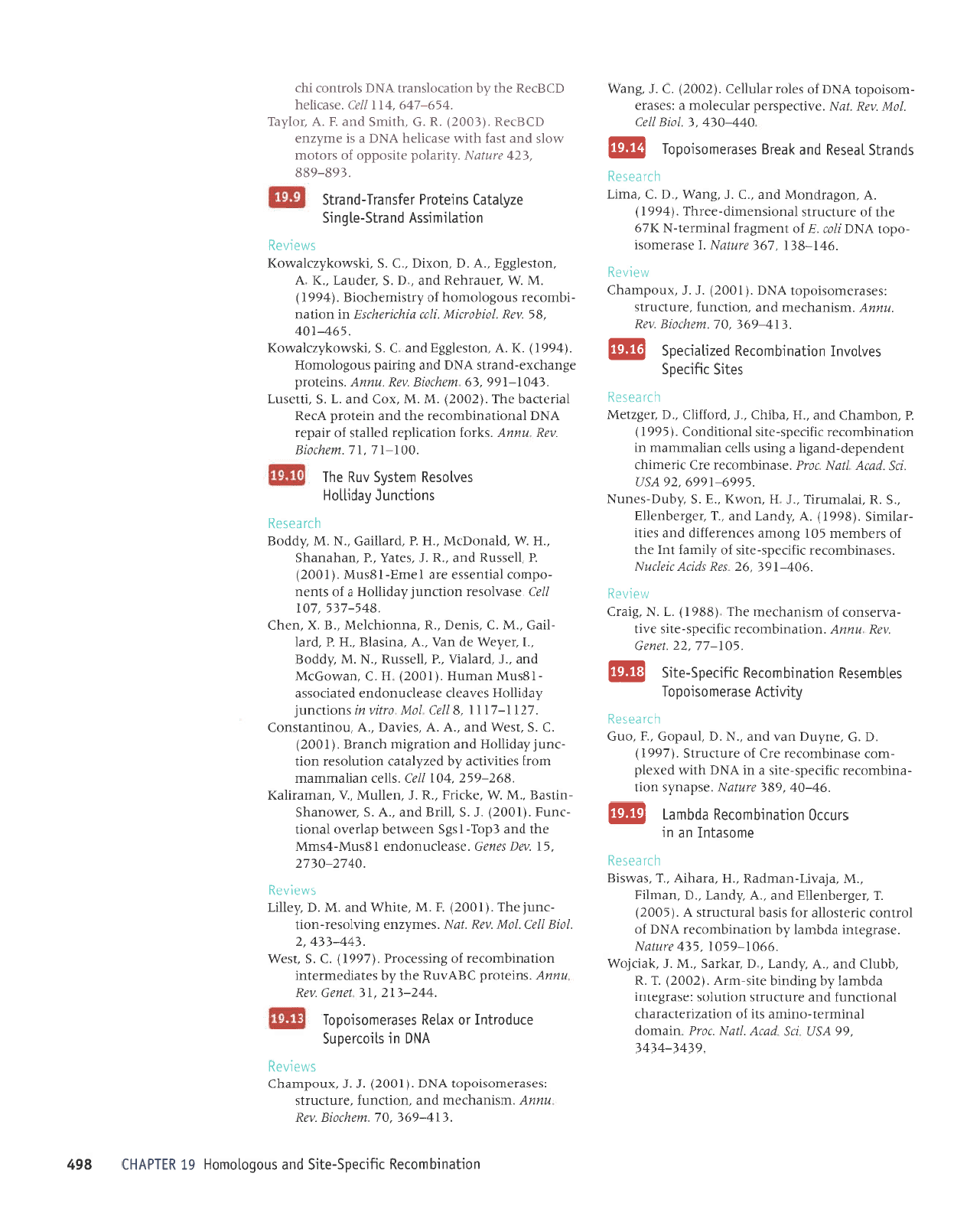
uoqeurquolau
rlJrrads-ails
puP
sn060louroH
6I
ulldvHl
'
f.
I v-69€' o L'
waLpj tg
-^)a
nuuv'
I[rslueLIJelu puP'uorDunJ'alnl)nrls
:sasprluosrodol
vNO
'(
t OOZ)
'1
'1 'xnodrueq3
sMarAau
vNo
u! slrolradns
alnpollul lo xelau sasPlauosrodol
'tvz-{.I..'
I€
puar'^aE
nuuv'sulei,ord
3gy..tng
aqt
dq saleparurelul
uortpurqruoJa-r
1o
Surssarord'
(L661)')'S'rsa14
'€rv-€(-v'z
'
lotg ItD' lory'AaA
7zr1"r'satuLzua
Sut.Llosar-uorl
-run[aq1
'(tOOZ)
U'W
'etlq6
pup
'W'(
^e6'I
sMarASu
'0117.-0tLZ
'sI'^aQ
sauaD' JsealJnuopue
I 8snw-7sruw
eqt
pup
Edol- ls8g
ueeMteq depa,,'o
1euot1
-rung
'(1667)
f
'S
'tlrS
pue
''V 'S
tauoupqs
-urlseg
"w
.M'a>lJrrc
"u'f
'uallnw''A 'uPuerITe>I
'
897-6SZ'101
il2D'slla)
uPlTPtulueur
ruoJJ sertrlrlJe
,,{.q
paz.(1eter
uortnlosJr
uorl
-runf
,1ep11o11
pue
uorler8nu
qruerg'(tOOZ)
') 'S 'rsaM
puP
''v 'Y 'ser^eo
"Y
'noulluelsuo)
'
L(I l-Ll I l'8
ttD low
uu^ r.r suon:unI
,{epr11o11
seAeelJ asealJnuopur
paterrosse
-
I8snw
uerunH
'(tOOZ)
H
')
'up,rloC)IAJ
puP
"f
'prelPr1'a 'llrssnu
"N'w
'^ppoB
'1 'ra,(a14
ap UPA
''V 'eursPlg
"H
a
'prel
-Iec
"I^l'J
'srua(
"u'Puuorq)lew "g
x'uaq)
.8'S_L€S ,LOI
11a,
'asellosrr
uortrun[,(epIIIoH e
Jo
stueu
-oduor
lerluassa
arp
IauA-I8snw'( I00Z)
a
'llrssnu
pue
''u 'f 'sele 'a 'ueqPuPqs
''H '71,1'pleuocrw ''H
a'plellreD
''N'w'Ippos
qlr easau
suor.llunC
r{eprt1o11
sa^losau
uels/{s ^nu aql
'00I-I
I
'IL'wa4)019
'^aA
nuuv's>lroJ uorlprlldar
pa11e1s
;o
-rredar
VNC
lpuoltpurquo)JJ
Jql
pup
uratord
yr:g
Iprralrpq
aql'(2002)
'W 'W 'xo)
pup
'T 'S 'Iltesn-I
'
€VOy-I66
'€9
waLpotg
'^a[ -nuuv
'suralord
a8ueqrxa-puerts
VNCI
pue
Surrred
sno3o1ouro11
'@aot)'y'y'uotselE8E
pue
3'5'r1s,lo>1.{z)leMo>I
'sgr-t0v
'85',^au ',plq1ntw'qu
DlLpua4)sg ur uorlPu
-rqruo)er
snoSoloruoq
yo .{rtsrtuaqrols
'(t66
I )
'IN .M
lenPrqeu
puP
'
(
's
tepne'I
">I
Y
'uorsa138E ''V'C 'uoxrq '') 'S 'r{smo>1,,(zrlerr,to;
sMatAau
uorlEl rrx rssv
puPlls-al6u
rs
azril e1e3 su ralord leJsuell-pu
prls
'€68-688
'€ZV
arntaN'.{trrelod alrsoddo
Jo
srolou
,tlols
pup
lseJ
qlrM
rsp)rlrq
VNCI
e sl au,{zua
C)g)aU
(EOOZ)
'U'D'ql1rus
pue'C'V
?o1de1
'vs9-
Lv9'vII
ila)'rseJllaq
CI)graU
aql dq uoqerolsuprl
VN(
slortuoJ rrp
86'
'6€.1{,-t{-v€-
'66VSn
nS
pnv'U0N')2rd
urPuop
IPUrrural-OUrIUe
Slr
JO
UOrlpZrrJlJerpqJ
IeuortJunJ
pue
arnlf,nrls
uortnlos
:aserBatur
epqrupl Lq Supurq
etrs-rurv
'(ZOOZ) 'f 'U
'qqnl)
pue
''y
,{pue1
'
C
're{res ''ry '1 '1ep[o6
'990I-690I 'EEV
atnlaN
'ase:8atur
ppqrupl
.{q uorteurqruo)er
VNC
Jo
Iortuo)
)rrrtsolle roJ
srspq
Iprntrnrts
V
'(E002)
'1 'ra8raqualg
pup
''V
Lpuel
''C 'uprulrC
''yg 'efearl-ueuppg
''H 'ereqrv
"I'seMsrg
q}
easau
auosPlul uP ur
srnllg uollPurquolau
ppquq
@
'91-OV
'68f
arruoN
'asdeu^s
uort
-purqruoJJr
l;nads-e1rs
e ul
VNCI
qtr,n
paxald
-uro)
Jspurquo)JJ
JIJ
Jo
JlnlJnjls
'{L66
I
)
'q '9 'auLnq
uel
pue
''g
q
'1nedo5
'C 'ong
q
ll
Pasau
r{lLnLpy
asuauosrodol
selqurasau
uoqeurquolag
rgrrad5-a1rs
@
'sotLL'zz'pua)
'
laY nuuv' uorleurquroJa-r
rrlnads
-
alrs a.trl
-elrrsuo)
Jo
rusruer{rau
aqJ
(gg6I)
1
'1q '3rer3
MATA0U
'901-16€'92
saY spDV )DpnN
'sespurqruoJa:
rr;neds-a1rs;o ,{luey
lul
aql
Jo
srJqruJru
g0I
Euorue saJualaJJrp
pup
serlr
-rplnurs
'(eOAt) 'y
,{pue1 pup
''I
taEraquallg
''S 'U 'reletunrll ''f
H
'uoM)l
"A
'5
',{qnq-saung
'E669-r669
'26
VSn
'!)s'pnv
usN
)?Jd'JspurqruoJar
JJ) Jualurq)
tuopuedap-pue311
e
Sursn sllal uerletutueu
ur
uorleurqruorar
rr;oads-a1rs
Ipuortrpuo)'(EOO
t )
a'uoqueq)
pup
''H'eqlq) 'f 'proJJll)
''q 'ra3zra61
qlreasau
salrs l!JDe0s
sa^lo^uI uorleurquolau pazrleDads
EEE
'{.lt-69€
'0
L
'LuaLp)lg '^aa
'
nuuv' ufslueqJaur
pue'uorlJunJ'arnl)nJls
:sasereruosrodot
VN11
'(tOOZ) '1 '1
'xnodrueqX
MAtAAd
'9Vl-8{,1
',Lg€
afil0N'I
eserrruosr
-odot
VNO
l1o,
g
1o
tuau8erJ
Ipunurrt-N
>IZ9
aql
Jo
arnl)nrls
Ipuorsuaturp-aerqJ
'@ael)
'y 'uo8erpuow
pue
'') '1 '3ue14
''O ') 'prul.I
q
ll Pasau
spuerls
lpasau
pue
lparg
saspreuosLodol
@
jtt-o€tr'€'lola
ila)
'pW'^aA'7rrrg'earltadsrad
telnralour
e
:seseJJ
-ruosrodol
VNA
Jo
selor relnlle)
'(ZOOZI
3
'1
'3ue14
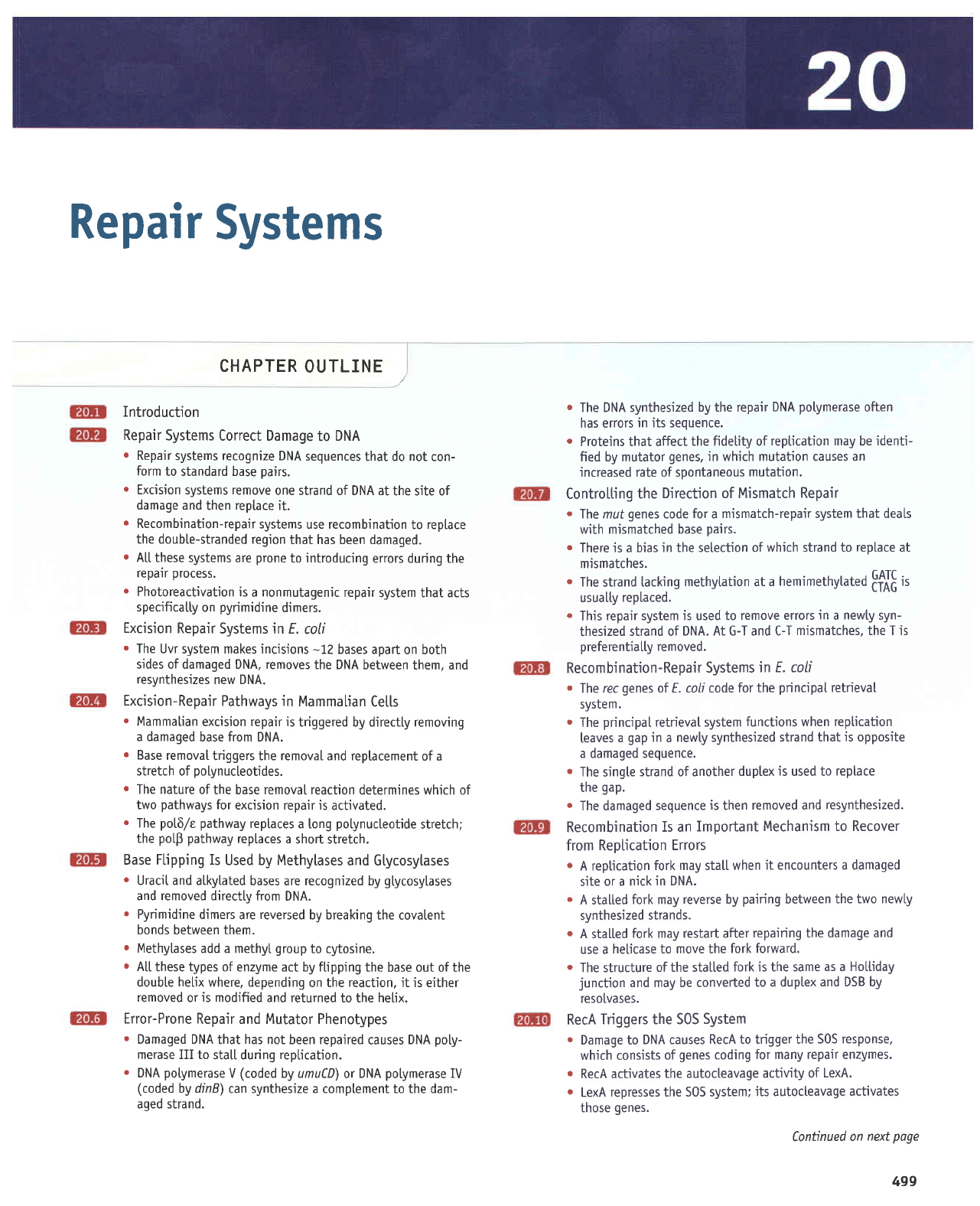
Repair
Systems
CHAPTER
OUTLINE
Introduction
Repair
Systems
Correct Damage
to
DNA
.
Repair
systems recognize DNA
sequences
that do
not
con-
form
to standard base
pairs.
r
Excision systems remove
one strand of DNA at
the site of
damage and
then
replace
it.
r
Recombination-repair
systems
use recombination
to
reptace
the
double-stranded region
that has been damaged.
o
At[
these systems
are
prone
to introducing
errors during the
repair
process.
r
Photoreactivation
is
a
nonmutagenic
repair
system that acts
specificatty
on
pyrimidine
dimers.
Excision
Repair
Systems in E.
coli
o
The
Uvr system makes incisions
-12
bases
apart on both
sides of damaged DNA, removes
the DNA
between them, and
resynthesizes
new DNA.
Excision-Repair
Pathways in
Mammalian
Cetls
.
Mammatian
excision repair is
triggered by directly removing
a damaged
base from DNA.
r
Base
removal
triggers the removal and reptacement
of a
stretch of
potynucleotides.
r
The nature
of the base removal reaction
determines which of
two
pathways
for
excision repair is
activated.
.
The
pot6/e pathway
reptaces
a long
potynucleotide
stretch;
the
potp
pathway
replaces a
short stretch.
Base Flipping Is
Used by Methylases
and Glycosytases
o
UraciI and atkyl"ated
bases are recognized by
glycosytases
and removed directty from
DNA.
o
Pyrimidine
dimers
are
reversed
by breaking
the covatent
bonds between them.
r
Methylases
add a methyl
group
to cytosine.
e
A[[
these types of
enzyme act by ftipping the
base out of the
doubte
hetix
where, depending
on the
reaction,
jt
is either
removed
or
is
modified and returned
to the hetix.
Error-Prone
Repair and Mutator Phenotypes
.
Damaged DNA
that has not been repaired
causes
DNA
poty-
merase III to
stall during
replication.
.
DNA
potymerase
V
(coded
by umuCD)
or
DNA
potymerase
IV
(coded
by dinB)
can synthesize a comptement to the dam-
aqed strand.
r
The DNA synthesized
by the repair DNA
potymerase
often
has errors
in its sequence.
o
Proteins that affect
the fidetity of
reptication may
be
identi-
fied by mutator
genes,
in which mutation causes an
increased rate of spontaneous
mutation.
Controtting
the
Direction of Mismatch Repair
.
The
mut
genes
code
for
a
mismatch-repair system that dea[s
with mismatched base
pairs.
.
There
is
a
bias in the setection of
which strand to
reptace
at
mismatches.
r
The
strand
tacking
methytation at a
hemimethytat.a
fflf
is
usuatty
rep[aced.
.
This
repair system is used to
remove errors
in
a
newly
syn-
thesized
strand of
DNA. At G-T and C-T
mismatches, the T is
preferentiatty
removed.
Recombination-Repair
Systems
in E. coli
.
The
rec
genes
of E. coli code
for the
principal
retrieva[
syste
m.
r
The
principal
retrieva[ system
functions when reptication
leaves
a
gap
in
a
newty synthesized
strand that is opposite
a damaged
sequence.
r
The
singte
strand of another
duptex
is
used to
reptace
the
gap.
r
The damaged
sequence
is
then
removed and
resynthesized.
Recombination
Is an
Imoortant
Mechanism to Recover
from Replication
Errors
r
A replication
fork may statl when
it encounters a damaged
site
or a nick
in DNA.
.
A stalled
fork may
reverse by
pairing
between
the two newty
synthesized
strands.
o
A stalled
fork may restart after
repairing the damage and
use a
heticase to move the
fork forward.
o
The structure
of the statted
fork is the same
as a Holtiday
junction
and may be converted
to a duplex
and DSB by
reso[va5es.
RecA
Triggers the S0S
System
.
Damage to
DNA causes RecA
to trigger the S0S
response.
which consists
of
genes
coding
for many repair enzymes.
r
RecA activates
the autocteavage
activity of
LexA.
o
LexA
represses the S05 system;
its autocteavage
activates
those
genes.
Continued
on
next
poge
499
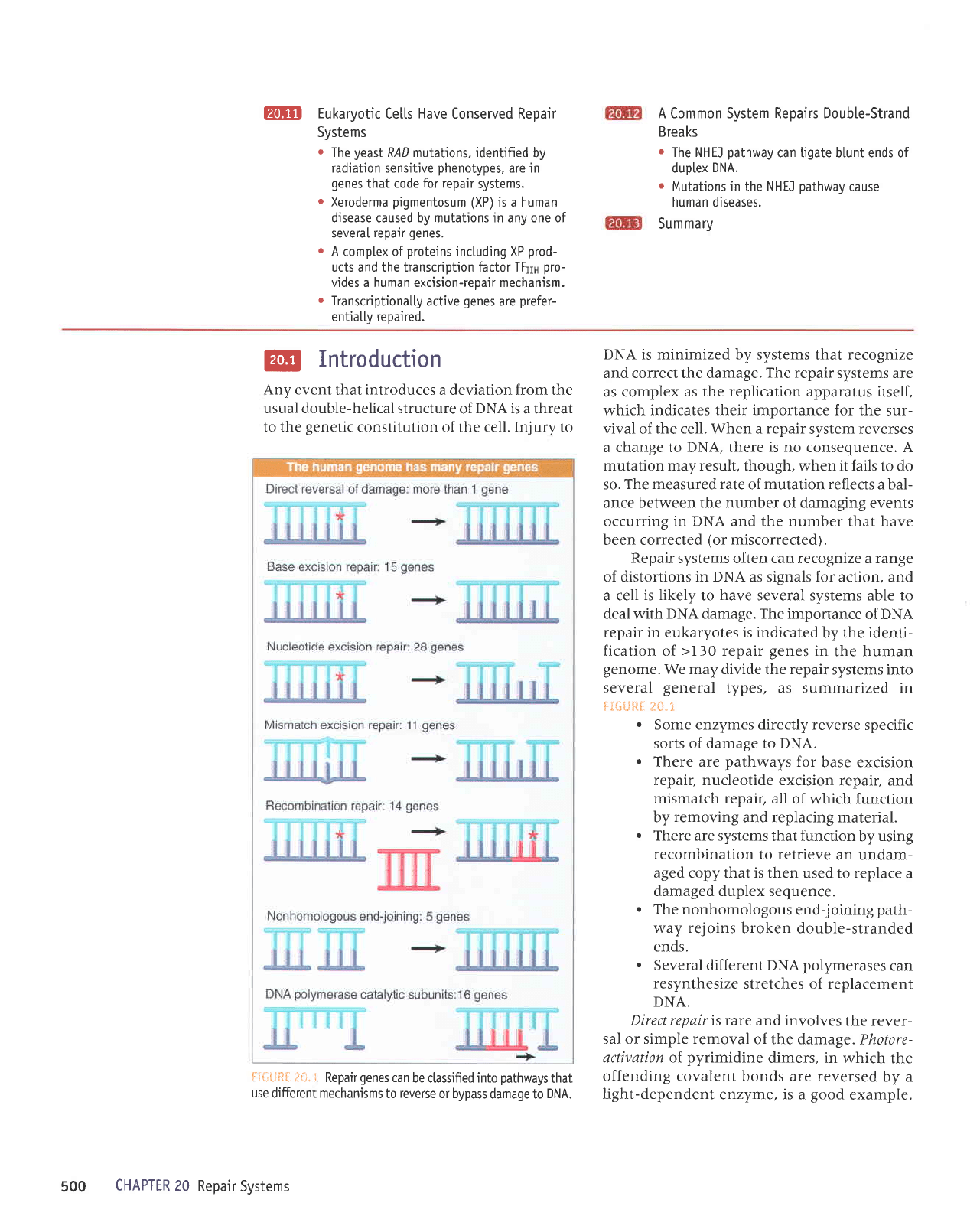
?Iifi/N
Eukaryotic
Cetts
Have
Conserved Repair
Systems
o
The
yeast
R/D mutations, identified
by
radiation sensitjve
phenotypes,
are in
genes
that code for repair
systems.
.
Xeroderma
pigmentosum (XP)
is a human
disease caused by mutatjons in any one of
severaI
repair
genes.
.
A complex of
proteins
inctuding XP
prod-
ucts and the transcription factor TFnr
pro-
vides a human excision-repair mechanism.
r
Transcriptionatly
active
genes
are
prefer-
entiatty
repaired.
A Common System Repairs Double-Strand
Breaks
o
The NHEJ
pathway
can ligate blunt ends of
dupLex
DNA.
o
Mutations in the NHEJ
pathway
cause
human diseases.
Summary
@
Introduction
Any event
that
introduces
a deviation from the
usual double-helical structure
of
DNA is
a threat
to the
genetic
constitution of the cell. Injury to
r!**lt[
f*.i
Repairgenescan
be ctassified into
pathwaysthat
use
different mechanisms
to
reverse
or bypass
damage to
DNA.
DNA is minimized by systems
that
recognize
and correct the damage.
The repair
systems are
as complex
as the replication apparatus itself,
which indicates their importance for the
sur-
vival of
the cell. When a repair
system reverses
a change to DNA, there
is no
consequence. A
mutation may result, though,
when
it fails
to do
so.
The measured rate
of
mutation
reflects a bal-
ance between the number of damaging
events
occurring
in DNA and the number
that have
been corrected
(or
miscorrected).
Repair systems often can recognize a range
of distortions in DNA as signals for
action, and
a cell
is likely
to
have
several systems able to
deal with DNA damage. The importance
of DNA
repair in eukaryotes is indicated
by the
identi-
fication of
>130
repair
genes
in
the human
genome.
We may divide the repair
systems into
several
general
types, as summarized in
F:ili-8ftil
g*.1
.
Some enzymes directly reverse
specific
sorts of damage to DNA.
.
There are
pathways
for
base excision
repair, nucleotide excision
repair, and
mismatch repair, all
of which function
by
removing
and replacing material.
.
There are systems
that function
by
using
recombination
to retrieve
an undam-
aged copy that is then
used to replace a
damaged duplex sequence.
.
The nonhomologous
end-joining
path-
way rejoins
broken double-stranded
ends.
.
Several different DNA
polymerases
can
resynthesize
stretches of replacement
DNA.
Direct
repair is rare and involves
the rever-
sal or simple removal
of the damage.
Photore-
activation of
pyrimidine
dimers, in
which the
offending covalent
bonds are reversed
by a
light-dependent
enzyme. is a
good
example.
s00 CHAPTER 20
Repair
Systems
